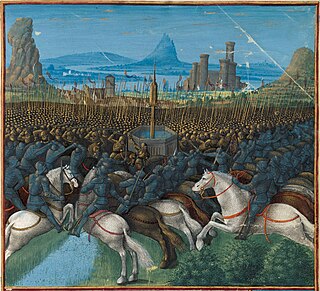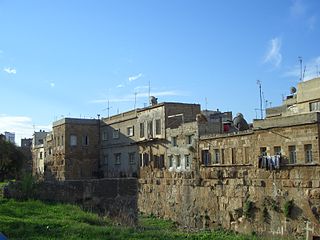Related Research Articles

The Poor Fellow-Soldiers of Christ and of the Temple of Solomon, also known as the Order of Solomon's Temple, the Knights Templar, or simply the Templars, was a Catholic military order, one of the most wealthy and popular of the Western Christian military orders. They were founded in 1119, headquartered on the Temple Mount in Jerusalem, and existed for nearly two centuries during the Middle Ages.

Jacques de Molay, also spelled "Molai", was the 23rd and last grand master of the Knights Templar, leading the order from 20 April 1292 until it was dissolved by order of Pope Clement V in 1312. Though little is known of his actual life and deeds except for his last years as Grand Master, he is one of the best known Templars.

Roger de Moulins was eighth Grand Master of the Knights Hospitaller from 1177 to his death in 1187. He succeeded Jobert of Syria. His successors were two interim masters, William Borrel and then Armengol de Aspa, before the permanent Grand Master Garnier of Nablus was selected in 1190.

Gérard de Ridefort, also called Gerard de Ridefort, was Grand Master of the Knights Templar from the end of 1184 and until his death in 1189.

The Battle of Cresson was a small battle between Frankish and Ayyubid forces on 1 May 1187 at the "Spring of the Cresson." While the exact location of the spring is unknown, it is located in the environs of Nazareth. The conflict was a prelude to decisive defeat of the Kingdom of Jerusalem at the Battle of Hattin two months later.

Robert IV de Sablé was Lord of Sablé, the eleventh Grand Master of the Knights Templar from 1191 to 1192 and Lord of Cyprus from 1191 to 1192. He was known of as the Grand Master of the Knights Templars and the Grand Master of the Holy and Valiant Order of Knights Templars.

Guillaume de Beaujeu, aka William of Beaujeu was the 21st Grand Master of the Knights Templar, from 1273 until his death during the siege of Acre in 1291. He was the last Grand Master to preside in Palestine.
Paul of Segni was an Italian nobleman and Franciscan friar who served as the bishop of Tripoli in the Levant from 1261 until 1285 and as a papal legate to the kingdoms of Germany and Sicily in 1279–1280. He was the most prominent churchman from the east at the Second Council of Lyon in 1274. After 1275, he was involved in a dispute with the bishop of Tortosa that took him to Rome. He spent his last five years in Italy.
William Borrel was acting Grand Master of the Knights Hospitaller, ad interim, from 1 May 1187 until his death at the Battle of Hattin in 1187. He became custodian of the Hospitallers after the Grand Master Roger de Moulins was killed in the Battle of Cresson on 1 May 1187.

Armengol de Aspa, also known as Hermangard d'Asp, was the ninth Grand Master of the Knights Hospitaller, holding the office from 1188 until his resignation in 1189 or 1190. He succeeded William Borrel who was interim Grand Master. It was under his magistracy that the headquarters of the Order was transferred from Jerusalem to Tyre. It was probably during the winter of 1189 or 1190 that Armengol's magistracy ceased, but this was not due to his death, since he appears again as lord of Amposta from December 1190 to April 1191. We have no information on what this first abdication in the history of the Order was, but he was succeeded by Garnier de Nablus sometime in 1190.

The history of the Knights Hospitaller in the Levant is concerned with the early years of the Order of the Hospital of St. John of Jerusalem, the Knights Hospitaller, through 1309. The Order was formed in the later part of the eleventh century and played a major role in the Kingdom of Jerusalem, in particular, the Crusades. This lasted until the West was expelled from the Holy Land, with the Order conquering Rhodes in the early fourteenth century. Among the most important internal events of the early years of the kingdom were the foundation of the Military Orders, which included the Hospitallers, the Knights Templar and the Teutonic Order. Unlike the Hospitallers' beginnings as a benevolent organization, the Templars and Teutonic knights began with a military mission. These three major Orders would play a major role in the military activities of the kingdom, sometimes cooperatively, sometimes not. On the battlefield they frequently shared among them the most important tactical roles, the vanguard and rear-guard.

The Citadel of Tartus,, is a historic building now mostly a residential area by the Mediterranean Sea in Tartus, Syria. It was one of the most important fortresses in the county of Tripoli.
Barthélemy de Quincy was Marshal of the Knights Templar during the mastership of Jacques de Molay.
Pierre de Severy was Marshal of the Knights Templar during the mastership of Guillaume de Beaujeu. He died during the Siege of Acre in May 1291.
Geoffroy de Vandac was Marshal of the Knights Templar during the mastership of Guillaume de Beaujeu.
Hugues de Montlaur was Marshal of the Knights Templar during the mastership of Armand de Périgord.
Robert Fraisnel or Robert Franiel was Marshal of the Knights Templar during the mastership of Gerard of Ridefort.
Hugues du Quiliou was Marshal of the Knights Templar during the mastership of Bernard de Tremelay.
References
- ↑ Guillaume-Rey 1888, p. 374.
- 1 2 Burgtorf 2008, pp. 534–535.